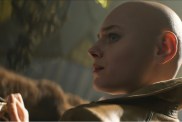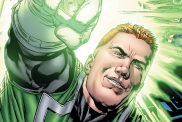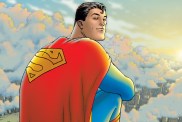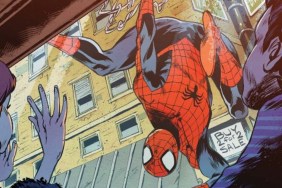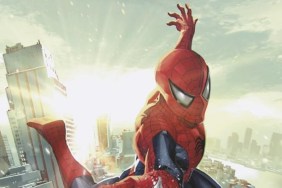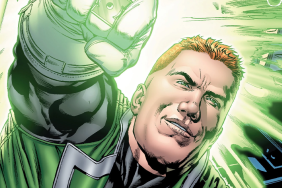He’s the President and CEO of Marvel Studios and the main man responsible for bringing Marvel Comics’ characters to life on the big screen… and he “couldn’t be more comfortable” with the work of Spider-Man 2. He is Avi Arad. “This movie shows clearly that we can tell the stories endlessly. We have great emotional stories to tell, we have the growth, and we manage to especially in the Spider-Man books, the villains are connected to Peter. It’s really easy to tell the stories, therefore, we feel very comfortable moving into the future.” Good news for us Spidey fans.
As Spidey fans, we know about the characters. But, Avi Arad does not take that for granted. “In order to make a good picture, you have to assume no one knows Doc Ock or Goblin, or any of these guys. You have to give a little bit of a backstory, connect it into the story emotionally and make it interesting. Then it really doesn’t matter if anybody knew about it. They all know Spider-Man, they all know Peter Parker, they all know that Sam is in the business of building Peter Parker up and giving him interesting villains, and at the end of this movie they will know these villains. So we don’t have an issue with that.”
The first movie was a success. Discussions for Spider-Man 2 started up right after the movie came out. “Being the first ‘Spider-Man’ movie then, it’s almost superstition. You don’t want to go on until you know what you have. We basically at the end of movie one had a pretty good feeling about the next story. Because after the origin story where we felt that audiences will be interested in what happens to all of them. We heard about their dreams and aspirations we saw Peter being bitten and destiny put him in a place. He sort of agrees to carry the mantle, but then we know that there was a great story, and how do you handle that? They all graduated, did Mary Jane get her dreams? I think Aunt May being a widow was really very interesting for us to deal with to show her strength. Harry losing his father and knowing that his number one enemy is Spider-Man, who happens to be his best friend. So there were so many complex emotional issues that we felt we needed to deal with, and personal growth. Everybody moves on, and Peter Parker being Spider-Man has the toughest time to achieve the normal goals. Hence, we got to Spidey no more. The vision, the direction for what we wanted to do with him in this movie, and everybody around him, was pretty clear from the unanswered questions in movie one. Therefore, as you walk out of this movie, again, you can start writing down all the issues that will be interesting to deal with in the next installment. We never planned it as a 3, 4 chapter story. Obviously the first one was the origin. Getting the voice of the characters, it was so successful that after that, again, story one gave birth to what ideas would be interesting. Where do we wanna see Mary Jane in the future? How is Peter going to deal with this touch decision he made? When you get all of these movies, there are really interesting opportunities for Peter and Mary Jane. Thought of the happy ending, if you will, but Marvel, there’s never a happy ending. So we make sure we take care of that in the next movie.”
Being Avi Arad and appreciating his experience, we wanted to know if he could sense what works and doesn’t work when adapting comics to the big screen. He answered, “Yeah. I think I started to understand better what doesn’t work. What does work is be courageous, and again, I cannot tell you how much credit I give Sony for letting Sam and us make a highly emotional movie, with a hero speech, with the kind of things – in all fairness to Hollywood – they’ll be so afraid to touch. ‘Oh, too emotional, too this, too that.’ So the one thing that worked for us and the books for 45 years is that the marvel stories are about emotions. The heroes have their faults, they cannot really enjoy the fruits of their fame, if you will, on the contrary, fame is what makes them technically fugitives. So as long as we stick to emotion, emotion, emotion, get deeper and deeper into the character. Test it. There are a lot of heroes for the minute, and it happens to policeman, military, fireman; then you go on with life. You go to the movies, watch baseball. Here is a guy that is doing it all the time. The only way to keep it honest is to test character. So the thing that we have to continue doing is more emotion, action has to be to the point. Can’t be just an action scene because we think that what the kids want to see. Everyone’s learning a pretty hard lesson over the last few years, you just can not do that. So it’s making our life easier when a studio embraces a vision. Sam is interested in the character. He knows the action, of course. But he’s interested in the character. As more studios will embrace this idea, everybody will be more successful.”
Emotion seems to be the heart of Sam and his team’s vision for Spider-Man. So, as far as Peter Parker goes, we wondered if this is as ‘low’ as his character gets. “Peter will get as low as we’ll take him. It’s the writer’s prerogative to take him. We think this is as low, actually, this is not really a tragic moment. Being a hero is a complicated commitment. We didn’t look at it as a low moment. We looked at it as something that an audience would like to understand, “Why is he doing it? How can he do it? How long will he stay with it? Don’t take it for granted.” So it’s more about showing how does one go through a process and actually that leads to the best moment where he realizes it. When you are being given a gift. Listen, Peter could’ve been the best cat-burglar in history, had a nice penthouse, a great life, but that’s what makes this kid so different. So it was a tough moment versus a low moment. Low moment was losing Uncle Ben, and that’s what defined his life forever.”

We can’t forget the real creator of Spider-Man…Stan Lee. Avi Arad comments on Stan Lee’s contributions to this Spidey web of production. “To begin with, he created the character. If you meet Stan Lee, Stan Lee now is older, but he’s still a Peter Parker. It’s such a copy of Stan it’s ridiculous. Talking to him yesterday it’s like, hello, nothing changed. So he’s spirit, and he’s writing. He wrote the books for a long, long time and these are the stories that endured. We have a writer, Brian Bendis, who came in and did ‘Ultimate Spider Man,’ and basically went back to Stan. Changed fashions, hair and what we’re interested in in today’s world. So Stan is in every page here, he read the scripts. We talk all the time. He loves Sam. He trusts Laura and myself, and he’s there. If we need him, we call him, we ask questions, would he do that, would he not, is it controversial. It’s his stories that we are telling.”
Visual effects. Gotta have ’em. It sounds like we’re going to be real lucky with the quality of the visual effects according to Avi. “At the end of the movie, we had a meeting and basically the meeting was, ‘Okay, we are moving forward. Going to the future. What are the goals? What do you wanna do better in the second movie?’ And if you remember the final shot in ‘Spider-Man,’ around the flag, it was probably the best CG section of the movie because it was the one we started first and finished last. And we set up a goal that all the shots in this movie should be as good as the last shot in the first movie. We were able to – SBI did an incredible job in – this movie, you saw the scope. This is not a two-year movie. This should’ve been a three-year movie. They did an incredible job with it. One of the goals we said to ourselves were we really wanted to accentuate new moves by Spider Man showing strength. The classic things, how much he can lift, and so on and so forth. We wanted to get into that. We wanted to get into vertigo, which, again, we couldn’t cover everything in movie one. In this movie, there was a lot of vertigo. You see him looking down and you kind of feel the fear. As far as – the train scene, that’s breaking many, many grounds. Most interesting was a combination of CG and physical, and puppeteering. Just finding puppeteers is a diminishing art – to do Doc Ock properly. So it was really very challenging and great.”
Now let’s talk villains. Has Avi ever come across the adaptation of a villain that just wouldn’t seem to work on the big screen? “So far so good. But again, when you go out to find a villain, especially for Spider-Man, the key has to be he’s connected to Peter Parker, or to Spider-Man, preferably to both. So far both movies took advantage of it. I think that will always be the golden rule. We don’t have villains. If you look at the Marvel Universe, these are people who run into ordinary circumstances and they made a left instead of a right. There’s not this predominant evil people who get up in the morning and say I’m going to conquer the world. We don’t play with these guys. We play with guys that something happened to them, an accident, mutation, something very personal. And out of it, they change and they become the villain if you will. But they have to be connected to the story. They cannot be an outsider.”
So, according to Avi Arad, it’s usually a director’s prerogative of how scary the villains can get. “When Sam came on this movie five years ago, it was very clear that there is something really distant and good about him and his love for Peter Parker and Spider-Man. That was his childhood hero. So when you have a guy like that at the helm, you have to put your trust in him. And I have to say, we’ve been together five years and there’s never been an issue, which is pretty common in filmmaking of saying, ‘Don’t go there because it’s bad for the character. Don’t go there because it’s not right for Peter Parker.’ He has an incredible responsibility. There’s a lot of Peter in him. He feels really responsible for this character, so he’s more careful than any of us.”
Sam Raimi, director of Spider-Man 2, picked the train scene as one of the most challenging scenes to film. We wondered why Chicago and not New York. “Tricks of the trade. Chicago has a train above ground. The only place you have a train above ground in New York is, you have an area in Queens where it comes out and goes over and there’s nothing around – there’s tressels, right? Open. No buildings. So it wouldn’t have made the most interesting situation, so we connected Chicago into New York and it was a 10-day, cold, and it worked great.”
We asked Sam Raimi to compare Peter Parker/Spider-Man as a hero in today’s world. As far as relating to Avi Arad, a new American citizen, what is American about Spider-Man and Marvel Comics? “Well I think first, Marvel Comics is a uniquely American form of art. Now comics are very big in Japan, but for here it was a way – something started in 1939 and comics always, they were sort of the Greek theater of society. They reflected our fears, our angst. If you look at radioactive spider, gamma ray, Hulk, Captain America fighting the Germans, it was basically taking the news and creating a hero to answer our issues. It’s about, to me, Peter Parker, actually when I first lived here, I lived in Queens, so I totally got it. I started reading Spider-Man in Hebrew, and I didn’t feel like it was different than the life that we had. So one of the things about this kid is that there are kids like that everywhere, in every culture, in different times in countries that are just starting to get to where Peter parker was in the ’60s. It’s the same aspirations. And kids like him are all over the world. To me, that was relatable, being in another culture and not even knowing what this place looked like. Because the character was the same. Believe me, kids that read comics where I come from were more like Peter Parker. You wouldn’t carry it in the open or you would get beaten up.”

Spider-Man 3? “I think it will be the same team, and more important it’s the same director. Way too early to tell you anything about it.” Spider-Man 4 or more? “Sure. We wanna go to nine. You’re looking at something that started in 1962, became on its own in 63, and thriving. Every time we do it, I think this movie, in my opinion, is better than the first one. I think we get the story. It’s not about planning 6, 7, 8. If we all sit around and get stuck, we say we really don’t have a story to tell, then we’ll stop. Spider-Man and Peter Parker are too valuable just to put them out there. I hope the characters don’t age too quickly. I don’t think so, they seem pretty young. Again, we shouldn’t think that far. But opportunities for material and stories within the Spidey universe, technically you can go on for a long time. We did 65 half-hours of an animated show, and we threw away something like 30 scripts when Fox at the time decided 65 half-hours was good enough.”
What’s coming soon for Marvel? “Well we are in the middle of shooting ‘Elektra,’ we are prepping ‘Fantastic Four,’ we are in pre-production on ‘Ghost Rider’ for Sony, and are moving ahead with ‘Luke Cage’ for Sony, and ‘X-Men 3’ will be out May 2nd, 2006. They give us release dates and we go running.”
The wait will be over on Wednesday, June 30, when Spider-Man 2 swings into theaters!
Source: Chuck the Movieguy
